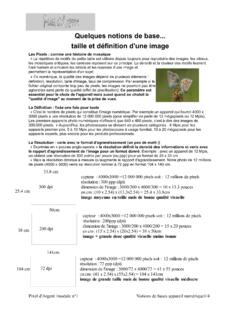Transcription of Models for wetland planning, design and management
1 EcoSys Bd. 8, 2000, 93-137 Models for wetland planning , design and managementMichael , Michele Dall'O' , Luigi Dal , Marcel De , Silvia Opitz1.,Luca , Jesper Persson2., Nico M. , Tiemo Timmermann6.,Giuseppe Bendoricchio4., Winfrid Kluge1. & Sven-Erik J Ecology Centre, Kiel University, Schauenburger Strasse 112, 24118 Kiel, Germany2 Dept. of Environmental Chemistry, Royal Danish School of Pharmacy, 2100 K benhavn, Denmark3 Limnology, Dept. of Ecology, University of Lund, Ecology Building, 223 62 Lund, Sweden4 Dipartimento dei Processi Chimici dell Ingegneria, University of Padova, Via Marzolo 9, 35131 Padua, Italy5 Freshwater Biological Laboratory, University of Copenhagen , Helsing rsgade 51, 3400 Hiller d, Denmark6 Dept. of Environmental Studies, University of Utrecht, Box 80115, 3508 TC Utrecht, The 942 wetland definition .. 943 Models as tools in environmental planning .
2 A scale based concept for wetland planning , design and management .. 984 planning at the catchment scale .. Catchment analysis .. Geographical Information Systems as a tool for spatial data management .. Selection of GIS based Models .. Siting and sizing of surface flow wetlands with a GIS based Score Nutrient 1095 wetland design .. Designing surface flow wetlands .. Designing groundwater fed wetlands .. 1146 management optimisation .. Water quality in freshwater, surface flow wetland .. Water flow and water budget in groundwater fed wetlands .. flow and transport Models .. budget calculation with FEUWAnet .. Water and nitrogen process based, dynamic model systems .. Biological interactions in networks .. 1277 model sources on the 133 Models for wetland planning , design and management941 IntroductionThe societal respect for wetlands has recently changed from former view of vast and wet lands,which have to be drained to fulfil economic purposes, to the now holistic view which regardswetlands as important multifunctional ecotones between terrestrial and aquatic ecosystemsproviding globally significant environmental, economical and social benefits.
3 Hydrologicallyundisturbed wetlands are linked with their surrounding terrestrial areas via several hydrologicalpathways including groundwater inflow, surface runoff or river water inflow. These various ofhydrological and hydrochemical conditions created by the mixing of different water sourcespromote a rich and abundant wildlife adapted to wet and often nutrient poor conditions. Importantwetland functions include storage of water, carbon and nutrients, groundwater recharge, stormprotection, flood mitigation, shoreline stabilisation, erosion control, and retention of carbon,nutrients, sediments and pollutants (DUGAN 1990). Economical benefits come from the direct use ofwetlands for fishery, forestry, peat cutting, as well as the indirect ecosystems services as nutrientand pollutant abatement for water quality improvement, or global climate regulation (COSTANZA etal.)
4 1997; DE GROOT 1992). Some wetlands are also valued highly for recreational activities withtourism as an important socio-economic factor. During the last decades, drainage and intensificationof agricultural and forestry land use resulted in wetland degradation and loss (EEA 1999).In many countries, wetland policy aims: (I) to conserve the remaining wetlands against present andfuture threats and (II) to implement landscape planning for the restoration and (re)construction ofdegraded wetland sites. The Ramsar Convention on Wetlands is a widely and internationallyaccepted political basis for world-wide wetland planning and conservation focusing originally onnature conservation and biodiversity. Water authorities have expressed the importance of wetlandsas sinks and transformators in the water and nutrient cycle at the landscape level in many officialdocuments European Nitrate Directive, the proposed European Water Framework Directive, theUnited States Clean Water Act or the Agenda the future, wetlands will be important multifunctional landscape elements in a sustainable landuse planning .
5 In this process, Models are valuable tools to improve wetland planning andmanagement activity at different spatiotemporal scales. The aim of these guidelines is to promotethe use of Models for effective wetland conservation and management . Therefore, these guidelinespresent a scale based concept for wetland planning , design and management . In this concept,different Models are described with their specific objectives, limitations, input and output data, andparameters and are illustrated with application examples. The model selection in this paper is basedon the experiences of the young researchers, which were employed during the WET project, and istherefore wetland definitionThe term wetland covers a wide spectrum of habitats under different hydrological andhydrochemical conditions including mires, fens, bogs, marshes, swamps, coastal areas, rivervalleys, ponds and small lakes.
6 Important variables used in wetland classification are water level,EcoSys Bd. 8, 200095nutrient status, water sources, vegetation composition and structure, and water flow patterns. Thehigh variability of wetlands is expressed in official definitions like Article 1 of the RAMSARC onvention on Wetlands: For the purpose of this Convention wetlands are areas of marsh, fen, peatland or water, whether natural or artificial,permanent or temporary, with water that is static or flowing, fresh, brackish or salt, including areas of marine water,the depth of which at low tide does not exceed six metres. European Environmental Agency has adopted this definition in their working programme(EEA 1999). The US-Environmental Protection Agency defines wetland in the Federal Manual forIdentifying and Delineating Jurisdictional Wetlands (1989) in the following way: Those areas that are inundated or saturated by surface or ground water at a frequency and duration sufficient tosupport, and that under normal circumstances do support, a prevalence of vegetation typically adapted for life insaturated soil conditions.
7 Wetlands generally include swamps, marshes, bogs, and similar areas. US-EPA, 40 CFR and CE, 33 CFR wide definitions are useful to include a broad spectrum of areas for administration , they cause problems for wetland management which always has to take the specifichydrological and hydrochemical conditions into account. These guidelines are restricted to inlandwetland ecosystems only and distinguish between surface flow (freshwater) and subsurface flow(groundwater) surface flow wetlands the inflowing water is flowing over the soil surface at shallow main water source in the water budget is river inflow. The sediments in surface flow wetlandshave a low hydrological conductivity. Typical examples for freshwater, surface flow wetlands areponds, shallow lakes, terrestrialization fens, and frequently inundated areas along rivers and subsurface flow wetlands, the inflowing water is mainly flowing under the soil surface througha permeable soil layer weakly decomposed peat, sand or gravel.
8 The main water source innatural subsurface flow wetlands is groundwater inflow. Typical examples are spring mires,percolation mires, or buffer zones along many natural wetlands, both freshwater, surface and groundwater, subsurface flow pathwaysoccur. These hydrological conditions create a vegetation pattern depending on the quantity ofdifferent inflowing water variety of wetland functions such as maintaining biodiversity, water quality improvement,harvesting or recreation leads to a diversification of goals in wetland planning and is visible in abranch of terms natural, seminatural, degenerated, constructed, reconstructed, restored, Constructed wetlands are principally designed to serve as water quality improvement orstorm water control. However, in many cases constructed wetlands are designed for multifunctionalpurposes including recreation, fishing, hunting, etc.
9 (PERSSON 1999; BENDORICCHIO et al. 2000).3 Models as tools in environmental planningModels are a valuable and widely used tool in environmental planning . Effective environmentalplanning often demands qualitative and quantitative predictions of the effect of future managementactivities as arguments for policy makers and administration. Models are applied to solve a widerange of wetland related problems under very different situations including: Models for wetland planning , design and management96 An environmental agency wants to quantify the effect of restored surface flow wetlands on waterquality improvement at a catchment scale for the development of a wetland restorationprogramme. A municipality plans to restore (reconstruct) a degenerated wetland and wants to know the effectof different wetland water levels on the water levels in the surrounding terrestrial area to avoidconflicts with neighbouring landowners.
10 A wetland manager has to maintain the efficiency of nutrient removal processes in a wetlandand wants to know how different management strategies moving or sediment removal effectquantitatively the efficiency of removal processes to ensure a given water quality standard at question can only be answered through the application of Models ; but each problem requiresa different type and complexity of modelling approach. In this context, a model is simply defined asa tool to solve aim of this paper is to present different modelling strategies applicable in wetland planning , design or management . The following part gives only a short introduction into model theory,development and application, for a more comprehensive study the reader is referred to Freshwaterecosystems: modelling and simulation by STRASKRABA and GNAUCK (1985), the Fundamentals ofEcological Modelling by J RGENSEN (1996), or CHAPRA (1997) Surface Water-QualityModeling.







